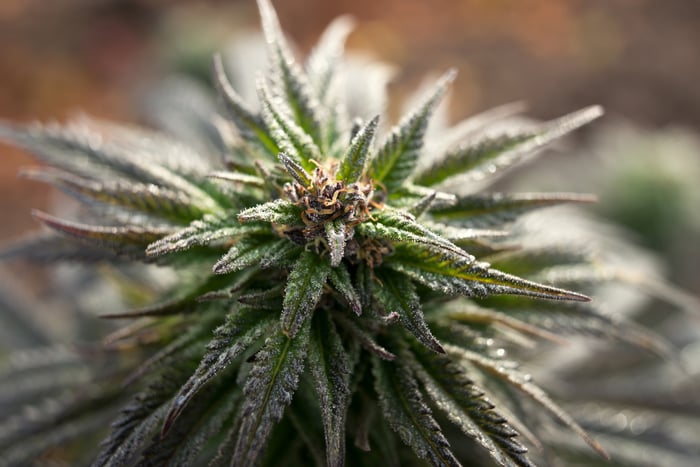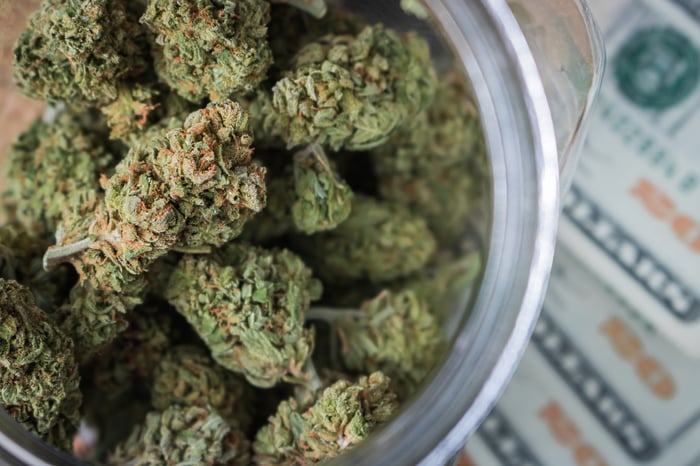Marijuana Stock Bubble 2.0 Is Here

You'd struggle to find an industry that's generated more robust returns than cannabis in recent months. The ETFMG Alternative Harvest ETF, a basket fund that contains an assortment of direct and ancillary marijuana stocks, is up 212% since the end of October (through Feb. 10).
Some individual pot stocks have performed multiple times better. Sundial Growers (NASDAQ:SNDL), Tilray (NASDAQ:TLRY), Aphria (NASDAQ:APHA), Aurora Cannabis (NYSE:ACB), and HEXO are up a respective 2,280%, 1,190%, 535%, 388%, and 341% since the end of October.
It begs the question: What are investors smoking?

IMAGE SOURCE: GETTY IMAGES.
Here's why cannabis stocks are going "bong-kers"
In recent weeks, multiple factors have made pot stocks all the buzz.
To begin with, Democrats taking control of Congress and the Oval Office could bring about real federal cannabis reforms. During the previous administration, Republican Mitch McConnell repeatedly kept cannabis legislation from reaching the Senate floor as Senate Majority Leader. Now, as Senate Minority Leader, McConnell no longer holds the same power. New Senate Majority Leader Chuck Schumer has been clear that he intends to co-draft legislation to legalize marijuana in the U.S.
As a quick reminder, Gallup's national sentiment poll on cannabis showed that an all-time record 68% of respondents in 2020 favored the idea of legalization. More specifically, 83% of self-identified Democrats want to wave the green flag on marijuana, compared to only 48% for self-identified Republicans.
Secondly, long-awaited consolidation is underway. In mid-December, Aphria and Tilray announced their intention to merge and create the largest cannabis company by annual sales. Combining these two businesses will result in tangible cost synergies, improved global reach, and a huge portfolio of derivatives (e.g., edibles, beverages, vapes, concentrates, oils, and topicals) that should boost overall operating margins.
Thirdly, the North American pot industry is exhibiting signs of maturity. Following its fiscal third-quarter earnings release, Canopy Growth (NASDAQ:CGC) announced that it will generate positive operating cash flow by fiscal 2023, along with positive adjusted earnings before interest, taxes, depreciation, and amortization (EBITDA) by the latter half of fiscal 2022. Meanwhile, many U.S. multistate operators are expected to turn the corner to recurring profitability in 2021.

IMAGE SOURCE: GETTY IMAGES.
Canadian pot stocks have entered "Bubble 2.0"
This probably all sounds great, but we've been here before. Canadian pot stocks have promised investors the moon in the past, only to disappoint them. Based on the share price appreciation we've witnessed in recent weeks, it seems like Canadian marijuana stocks are again about to harsh shareholders' mellow.
As much as the polling suggests that the American public favors legalization, actually passing it just isn't that easy. Unless Democrats were to abandon the filibuster in the Senate, which is unlikely, 60 votes would be needed to pass any cannabis legislation. That means getting 10 Republican senators to cross the aisle, which will undoubtedly be a tough task.
Even if House Speaker Nancy Pelosi and Senate Majority Leader Schumer successfully pass legislation to legalize marijuana, it's unclear if President Joe Biden would sign it. Biden campaigned on the idea of decriminalizing and rescheduling cannabis -- not legalizing it. Let's not forget that Biden is behind some bills crafted three decades ago that targeted drug users and dealers with harsh sentences.
It's also not clear that the current consolidation wave in the marijuana space is occurring out of strength. Although Wall Street and investors have lauded the Aphria-Tilray merger, finding a partner seemed like more of a necessity for Tilray than Aphria. Tilray had been burning through its cash at an extraordinary rate and relying on share and debt offerings to raise capital. This isn't what I would consider a merger of strength.

There are serious disconnects in the underlying fundamentals, as well. The aforementioned Canopy Growth report that got Wall Street excited featured another quarter with a huge cash outflow ($135.4 million Canadian) and a steep net loss of CA$829.3 million. Canopy Growth nearly had CA$5 billion in cash and cash equivalents on hand following a large equity investment from Constellation Brands in November 2018. It now has less than CA$1.6 billion in cash and short-term investments. The company has been bleeding cash for years and is still a long way from recurring profitability.
Canadian pot stocks also have a habit of destroying shareholder value through multiple rounds of share offerings and debt-to-equity swaps. While Tilray and Canopy Growth have issued an extensive number of shares over the years, neither holds a candle to what Aurora Cannabis and Sundial Growers have done to their shareholders. Aurora's outstanding share count has catapulted by over 12,200% since June 2014, whereas Sundial's outstanding share count has risen by more than 1 billion shares since the end of September.
The Canadian cannabis industry can succeed over the long run, but investors aren't being rational if they expect a rocket launch after years of underperformance.
It's time to face the facts: Marijuana stock bubble 2.0 is here, at least for Canada.
This article represents the opinion of the writer, who may disagree with the "official" recommendation position of a Motley Fool premium advisory service. We're motley! Questioning an investing thesis -- even one of our own -- helps us all think critically about investing and make decisions that help us become smarter, happier, and richer.
420 Intel is Your Source for Marijuana News
420 Intel Canada is your leading news source for the Canadian cannabis industry. Get the latest updates on Canadian cannabis stocks and developments on how Canada continues to be a major player in the worldwide recreational and medical cannabis industry.
420 Intel Canada is the Canadian Industry news outlet that will keep you updated on how these Canadian developments in recreational and medical marijuana will impact the country and the world. Our commitment is to bring you the most important cannabis news stories from across Canada every day of the week.
Marijuana industry news is a constant endeavor with new developments each day. For marijuana news across the True North, 420 Intel Canada promises to bring you quality, Canadian, cannabis industry news.
You can get 420 Intel news delivered directly to your inbox by signing up for our daily marijuana news, ensuring you’re always kept up to date on the ever-changing cannabis industry. To stay even better informed about marijuana legalization news follow us on Twitter, Facebook and LinkedIn.




